

Southern right whales are often spotted along the Plettenberg Bay coast. A group of scientists plan on recording all whale species encountered and to photograph southern right whales along the coastline from next week. Photos: Ewald Stander
Plettenberg Bay’s coastline will come under the spotlight over the next few days with the University of Pretoria’s mammal research institute’s whale unit conducting its annual aerial survey of southern right whales in the area.
Local marine mammal researcher Dr Gwenith Penry said the group was expected to arrive in the area from about October 10.
“This will be the 38th year of the survey, which has been monitoring the recovery of the right whale population along the South African coast,” Penry said.
The unit in a statement said that the survey, which has the necessary permits, would be conducted from an Airbus H120 helicopter at an altitude of about 300m, about 500m to 800m offshore between Nature’s Valley near Plett and Muizenberg in Cape Town.
The group plan on recording all whale species encountered and photograph all groups of southern right whales comprising a cow-and-calf pair, or animals with distinctive brindle coloration and markings while the helicopter hovers above the group.
The unit’s volunteers explain that vertical images of the heads and backs of the animals allow for individual identification as whales could be recognised from the patterns of callosities – wart-like growths – on their heads.
Photography of each group usually takes less than five minutes, during which time the helicopter hovers some 150m to 300m above the whales, before continuing the search efforts at about 300m.
“Although in areas of high whale densities the aircraft may move directly from group to group at the lower altitude. All surveying is carried out under a permit from the Department of Environmental Affairs to approach whales and under specific marine protected area permits from conservation authorities. Weather plays an important part in achieving the full survey coverage and flying will be required over weekends,” researchers said.
After the survey, the collected identification photographs and associated data are analysed. The best images of each individual are selected from each encounter and these are compared to the unit’s catalogue of identification photographs of just fewer than 2 000 recognisable adults from the previous 37 annual surveys.
Sorting of images is initially done using a computer-based image recognition system, followed by final matching of the whales by eye.
“These analyses allow for sighting histories of known individuals to be compiled and consequently for both the movements and distributions of individuals to be investigated. It also allows for the reproductive or calving histories of individuals to be investigated.”
Researchers said that these provided a suite of information on the vital parameters of the population, including abundance estimation, population growth rate, survival, calving intervals and age at first parturition (act of giving birth) – all of which were used to model the population demographic parameters.
Southern right whales were heavily whaled historically, particularly between 1780 and 1835. The global population is estimated to have been reduced from between about 70 000 to 80 000 individuals to less than a few hundred by the time of international protection in 1935.
“With the local population increasing at about 7% per year and with about 5 000 to 6 000 individuals, southern right whales have showed a strong recovery to date and the annual survey provides us with important conservation data with which to monitor this recovery. Numbers were lower than expected last year so researchers are curious to see what this year’s survey turns up.”
Article posted in Knysna-Plett Herald













